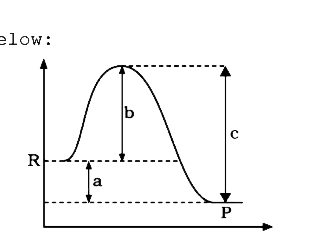The chemical reaction : A → P, ΔH∘ = 2.8 kJ is spontaneous only above 400 K. Therefore ΔS of reaction must be at least (JK−1).
The correct Answer is:7
To solve the problem, we need to determine the minimum value of the entropy change (ΔS) for the reaction A → P, given that the reaction is spontaneous only above 400 K and that the standard enthalpy change (ΔH) is 2.8 kJ.
1. Understand the Conditions: The reaction is spontaneous at temperatures greater than 400 K. This means that at 400 K, the reaction is at equilibrium, and the Gibbs free energy change (ΔG) is zero.
2. Use the Gibbs Free Energy Equation: The Gibbs free energy change is given by the equation:
ΔG=ΔH−TΔS
At equilibrium (400 K), we set ΔG to 0:
0=ΔH−TΔS
3. Convert ΔH to Joules: The given ΔH is 2.8 kJ. We need to convert this into joules:
ΔH=2.8kJ=2.8×103J
4. Substitute Known Values into the Equation: Now we can substitute ΔH and T into the equation:
0=2.8×103J−(400K)ΔS
5. Rearrange to Solve for ΔS: Rearranging the equation gives:
(400K)ΔS=2.8×103J
ΔS=2.8×103J400K
6. Calculate ΔS: Performing the division:
ΔS=2800J400K=7J/K
7. Conclusion: Therefore, the minimum value of ΔS for the reaction is:
ΔS≥7J/K
Final Answer:
The value of ΔS must be at least 7 J/K.
ΔG=ΔH−TΔS
At equilibrium (400 K), we set ΔG to 0:
0=ΔH−TΔS
ΔH=2.8kJ=2.8×103J
0=2.8×103J−(400K)ΔS
(400K)ΔS=2.8×103J
ΔS=2.8×103J400K
ΔS=2800J400K=7J/K
ΔS≥7J/K
The value of ΔS must be at least 7 J/K.
Topper's Solved these Questions
- THERMODYNAMICSBOOK - AAKASH INSTITUTE ENGLISHCHAPTER - THERMODYNAMICSEXERCISE - SECTION-H
3 Videos
- THERMODYNAMICSBOOK - AAKASH INSTITUTE ENGLISHCHAPTER - THERMODYNAMICSEXERCISE - SECTION-I
9 Videos
- THERMODYNAMICSBOOK - AAKASH INSTITUTE ENGLISHCHAPTER - THERMODYNAMICSEXERCISE - SECTION-F
3 Videos
- THE SOLID STATE BOOK - AAKASH INSTITUTE ENGLISHCHAPTER - THE SOLID STATE EXERCISE - Assignment (SECTION - D) (ASSERTION-REASON TYPE QUESTION)
20 Videos
Similar Questions
In a chemical reaction, ΔH=150kJandΔS=100JK−1 at 300 K. Therefore, ΔG will be
View SolutionIf for a reaction A(s)→2B(g),δU+1.2kcaland δS=40calK−1 at 400K then deltaG for the reaction will be (R=2calmol−1K−1
View SolutionFrom the reaction P(White) → P(Red) ΔH=−18.4KJ, it follows that :-
View Solution2C+O2→2CO,ΔH=−220kJ which of the following statements is correct for this reaction
View SolutionStatement-1 : All the exothermic reactions are spontaneous.
And
Statement-2 : For a spontaneous reaction, ΔG must be negative.
View SolutionThe potential diagram for reaction R→P is given below:
ΔH∘ of the reaction corresponds to the energy

View SolutionFor the reaction at 25∘C,C2O4(l)→2XO2(g)
ΔH=2.1kcal and ΔS=20calK−1 . The reaction would be :
View SolutionWhich reaction, with the following values of ΔH, ΔS, at 400 K is spontaneous and endothermic?
View SolutionThe value of log10K for the reaction :A↔B , If ΔH∘ = - 55.07 kj mole−1 at 298K. ΔS∘=10jK−1mole−1 at 298 K , R = 8.314 jK−1mole−1
View SolutionFor a hypothetical reaction A(g)+3B(g)→2C(g).ΔH=−100kJandΔS=−200Jk−1. Then the temperature at which the reaction will be in equilibrium is
View Solution
